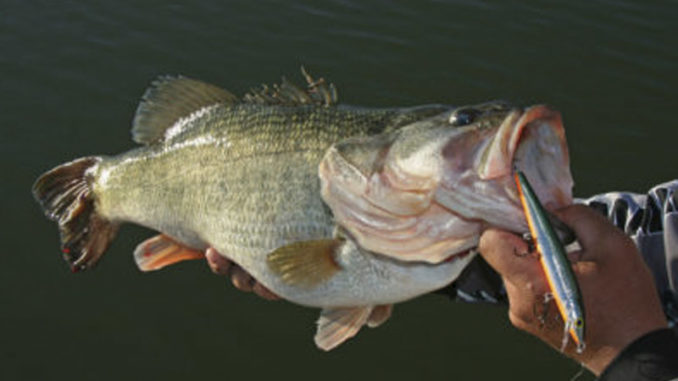
Long, skinny hard baits will fool bass in clear water from October through March
When you think of baits that bass fishermen turn to in the fall, you think of moving baits like crankbaits and spinnerbaits. A lot of people overlook a hard jerkbait, because everybody thinks about fishing them in late winter and early spring. If you think about it, late October, November and December can fish a lot like late winter and early spring, with baitfish relatively shallow and the water relatively clear.
When the water starts to cool late in the fall, bait does tend to get shallow, especially blueback herring if you’re fishing a lake that’s got them. If you aren’t, the shad also migrate back into the creeks and coves and get shallow. The largest part of the bass population is going to be right where the baitfish are. That’s where I use my Humminbird down-imaging and side-imaging unit to find bait in the creeks that hold a lot of bait, and I try to fish around it.
This is where a problem comes in. In most of the lakes in the Carolinas, it’s hard to get bass to bite, because they’ve literally got hundreds of thousands of shad or herring where they’re living that they can eat. And that’s where a jerkbait can get you bites when other baits you might think to pick up first won’t.
This about it; everybody has a jerkbait tied on in February and March, when you have cool, clear water and baitfish moving shallow. Those conditions are a perfect match for November and December. You can use one to imitate a shad or a herring, and you can fish the depths that the bait like to get in. I don’t really tie one on until late October, because in September and early October, the bait is going to be deeper than you can fish a jerkbait, which is usually only 4 or 5 feet deep.
I start fishing a jerkbait like a Rapala Shadow Rap Shad or Shadow Rap Deep in late October when the water starts cooling off. As November progresses, and by the end of November, the water is cold enough that the shad will be acting differently. Those two baits have a cool action, because when you jerk and pause them, they have a little “dying quiver” action, a very slow rise. Tons of baits on the market will suspend, but not a lot of them will suspend with their heads tilted forward like these.
The big thing you have to learn — with every jerkbait you tie on, different kinds and different sizes — is how deep they will run. Variables include different rods that will cast them different distances, on different lines. For example, a jerkbait will run deeper on fluorocarbon than monofilament. You need to find out how deep that bait will run, so you can get it to the right depth where the bait and bass are holding.
Down, suspended?
I will use a crankbait in late October and November if I think the bait has to touch bottom, if there’s some brush or cover that I want to bring it through. But if I see a lot of bait back in a creek, and there isn’t a lot of cover, then I’ll throw a jerkbait. With a crankbait, you want to make contact with cover, but when the bait is suspended, you want a jerkbait. A Shadow Rap Shad or Shadow Rap Deep has a very erratic action, and sometimes, that’s what it takes to catch suspended fish.
I’ll fish jerkbaits on a medium-action, 6-foot-6 to 7-foot baitcasting rod and a reel spooled with 10- to 12-pound fluorocarbon. I like the way fluoro lets a bait get down a little deeper; it can actually make a differences of a foot or a foot-and-a-half. Unless I am fishing over vegetation, I want to get them deeper. If you’re fishing in 10 feet of water and have vegetation coming up to within a few feet of the surface, then you want to fish a jerkbait on monofilament.
I like shad or blueback colors in the fall: pro blue, or clear/blue back. And I’ll fish these baits pretty quickly. In the late winter or early spring, I might pause a bait for several seconds after I make a couple of twitches with my rod tip, but your pause in the fall needs to be short — one second at the most. You try to find the speed and cadence that the fish want anytime you get on the water; you want to find out which retrieve triggers them. Sometimes it’s methodical, sometimes fast and erratic.
This time of year, especially in November, fish are going to be schooling, so if I get them started biting a jerkbait, I’ll keep throwing it until they stop biting before I go to a different bait. But this time of year, if you get them fired up on a jerkbait, you’ll catch most of the fish in the same immediate area on a jerkbait.
One thing to think about: when the water really gets cold, then I’ll likely go to a Husky Jerk. It’s a little bit bigger bait, and its action isn’t as erratic as the Shadow Rap Shad or Shadow Rap Deep. Its action is more like a shad in cold water, slowly suspending.
I want to emphasize that I’ll fish a jerkbait all the way from late October to the end of March. Any time during that period, if I’m fishing in clear water, I’m going to have one tied on. They are so very effective, and so many fishermen miss out because they don’t start fishing one until January or February.

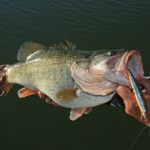
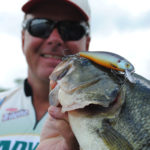

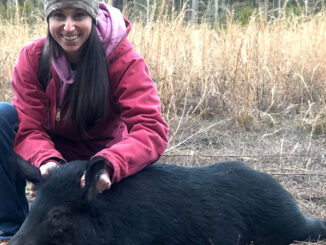
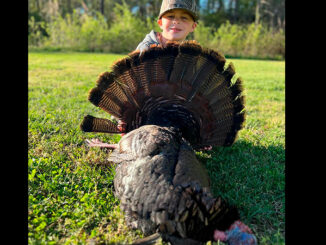

Be the first to comment